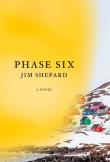Can Jim Shepard tell the future?
How else to account for the fact he had nearly completed his novel about a global pandemic, Phase Six, before COVID-19 descended on the planet?
Although Shepard’s seventh novel is triggered by an epidemic that is killing millions around the world, it focuses on three people: the young boy from Greenland, Aleq, who became patient zero and the two female scientists, Jeannine and Danice, who try to identify the pathogen that kills about a 33% of those who contract it (COVID’s morality rate is less than 1%).
 Ron Charles of the Washington Post observed: “Phase Six is best when it draws us into these three lives reshaped by a mysterious disease. While trying to save humanity, Jeannine and Danice must also deal with competing bureaucracies, demands from their own families, and waves of fear and grief as their friends and colleagues sicken and die. Despite their immense talent and ambition, they have reason to be discouraged. “All of those pathogens that over time we’ve de-adapted to – we keep sticking our noses everywhere, they’re all coming back,” Danice says. “Who would you put your money on? Humans have been around for what, two hundred thousand years? And bacteria for like three and a half billion.”
Ron Charles of the Washington Post observed: “Phase Six is best when it draws us into these three lives reshaped by a mysterious disease. While trying to save humanity, Jeannine and Danice must also deal with competing bureaucracies, demands from their own families, and waves of fear and grief as their friends and colleagues sicken and die. Despite their immense talent and ambition, they have reason to be discouraged. “All of those pathogens that over time we’ve de-adapted to – we keep sticking our noses everywhere, they’re all coming back,” Danice says. “Who would you put your money on? Humans have been around for what, two hundred thousand years? And bacteria for like three and a half billion.”
Shepard provides a nice overview of the biology of viruses and bacterium, and how scientists puzzle out the elusive mysteries of nature, but the heart of his novel is how human relations, the need for friendship, trust and plain old contact, remain fundamental even in the face of the apocalypse.
“The most powerful moments come at close range,” Bradley Babendir wrote in the Los Angeles Times. “When Jeannine and Danice are surveying Ilimanaq [Greenland] in search of information and survivors, they find the settlement’s only nurse in her home, her head “black with flies.” When they find Aleq, the only one left, his repeated request is that they bury his grandparents. Danice, overcome, turns to her colleagues and says, ‘It just seems impossible that it would be everyone.’ As the book progresses, it starts to feel not only possible but inevitable.”
The result is an engaging book that shows how even global catastrophes are processed through the lens of personal experience; how the ordinary endures even in the face of the extraordinary.
- Read an excerpt from Phase Six
- Read Jim’s piece about writing the novel
- Watch Jim read from and discuss his earlier work
Jim Shepard’s Top Ten List
1. Lolita by Vladimir Nabokov (1955).
2. One Hundred Years of Solitude by Gabriel García Márquez (1967).
3. The Trial by Franz Kafka (1925).
4. The stories of Anton Chekhov (1860–1904).
5. The Leopard by Giuseppe Tomasi di Lampedusa (1958).
6. Dubliners by James Joyce (1916).
7. The stories of Flannery O’Connor (1925–64).
8. The stories of Isaac Babel (1894–1940).
9. Waiting for the Barbarians by J. M. Coetzee (1980).
10. Memoirs of Hadrian by Marguerite Yourcenar (1951).